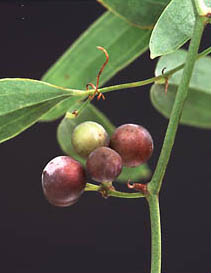
Plant Description
Caution & Interaction

Latin (botanical) name:
Smilax species
Common names: Bamboo Brier, Smilax Sarsaparilla, Black Creeper, Sarsaparilla, Sariva, Kalisar, Dudhilata, Sugandhi, Honduras Sarsaparilla, Red Sarsaparilla, Spanish Sarsaparilla, Tu fu Ling, Dwipautra
Plant Description: Sarsaparilla, a native of the southern United States, grows in swampy woods. It is a perennial vine, with a stout, square, prickly stem. It's leaves are elliptical-ovate and cuspidate. Three strong veins and two smaller, lateral, secondary veins run throughout. sarsaparilla blooms from May to August, with yellowish-white flowers in small umbels of three or four red or black 3-seeded berries.
Medicinal Properties &Uses: Sarsaparilla contains saponins, the flavor and foaming ingredient added to root beer and other soft drinks. Additionally, it contains calcium, copper, iron, iodine, manganese, potassium, silicon, sodium, sulfur, vitamins A, C, B-complex and D. For hundreds of years, sarsaparilla has been used to treat syphilis. It is known to purify the blood, lower blood pressure, and clean the colon and urinary tract. It is effective in reducing fevers as it cools down the body and promotes perspiration. Because it increases circulation to the joints, sarsaparilla is helpful in reducing inflammation caused by arthritis and rheumatism. In addition, sarsaparilla contains cortin, a hormone secreted by the adrenal glands. When the body produces insufficient amounts of this hormone, general weakness, illness, and nervous depression can occur. For those who suffer hypoglycemia or general exhaustion, sarsaparilla is an effective treatment. As a diuretic and diaphoretic, sarsaparilla has been used to assist weight loss programs by stimulating the body's metabolic process, increasing urination, and reducing water retention. It encourages excretion of toxins and waste materials, and acts as an antidote for various poisons. Heavy metallic contaminants in the blood can be extracted from the system with use of sarsaparilla.
Dosage: 30-60 drops in water or juice, 2-3 times daily or as needed. Shake well before using.
Cautions & Interactions: Keep out of reach of children.
Efficacy Studies & Other Clinical Data: Helpful Links:
Disclaimer (U.S. Only): These statements have not been evaluated by the FDA. These products are not intended to diagnose, cure, treat, or prevent any disease.
Common names: Bamboo Brier, Smilax Sarsaparilla, Black Creeper, Sarsaparilla, Sariva, Kalisar, Dudhilata, Sugandhi, Honduras Sarsaparilla, Red Sarsaparilla, Spanish Sarsaparilla, Tu fu Ling, Dwipautra
Plant Description: Sarsaparilla, a native of the southern United States, grows in swampy woods. It is a perennial vine, with a stout, square, prickly stem. It's leaves are elliptical-ovate and cuspidate. Three strong veins and two smaller, lateral, secondary veins run throughout. sarsaparilla blooms from May to August, with yellowish-white flowers in small umbels of three or four red or black 3-seeded berries.
Medicinal Properties &Uses: Sarsaparilla contains saponins, the flavor and foaming ingredient added to root beer and other soft drinks. Additionally, it contains calcium, copper, iron, iodine, manganese, potassium, silicon, sodium, sulfur, vitamins A, C, B-complex and D. For hundreds of years, sarsaparilla has been used to treat syphilis. It is known to purify the blood, lower blood pressure, and clean the colon and urinary tract. It is effective in reducing fevers as it cools down the body and promotes perspiration. Because it increases circulation to the joints, sarsaparilla is helpful in reducing inflammation caused by arthritis and rheumatism. In addition, sarsaparilla contains cortin, a hormone secreted by the adrenal glands. When the body produces insufficient amounts of this hormone, general weakness, illness, and nervous depression can occur. For those who suffer hypoglycemia or general exhaustion, sarsaparilla is an effective treatment. As a diuretic and diaphoretic, sarsaparilla has been used to assist weight loss programs by stimulating the body's metabolic process, increasing urination, and reducing water retention. It encourages excretion of toxins and waste materials, and acts as an antidote for various poisons. Heavy metallic contaminants in the blood can be extracted from the system with use of sarsaparilla.
Dosage: 30-60 drops in water or juice, 2-3 times daily or as needed. Shake well before using.
Cautions & Interactions: Keep out of reach of children.
Efficacy Studies & Other Clinical Data: Helpful Links:
Disclaimer (U.S. Only): These statements have not been evaluated by the FDA. These products are not intended to diagnose, cure, treat, or prevent any disease.